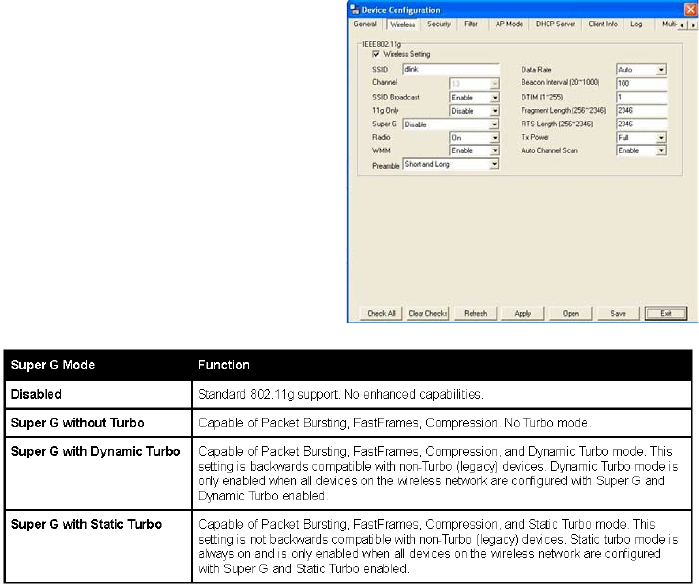
45
Device Conguration>Wireless
• SSID: The Service Set (network)
Identier of your wireless network.
• Channel: Allows you to select a
channel. 6 is the default setting.
• SSID Broadcast: Allows you to enable
or disable the broadcasting of the
SSID to network clients.
• Super G: Super G is a group of
performance enhancement features
that increase end user application
throughput in an 802.11g network.
Super G is backwards compatible
with standard 802.11g devices. For
ideal performance, all wireless devices
on the network should be Super
G capable. The modes are listed
below:
• Radio Wave: Enable or disable the wireless functionality of the selected device(s).
• WMM: Select Enable or Disable. Enable is selected by default. WMM stands for Wi-
Fi multimedia, by enabling this feature it will improve the user experience for audio
and video application over a Wi-Fi network.
• Preamble: Select the default value short and long, or long only .
• Data Rate: A pulldown menu to select the maximum wireless signal rate for the
selected devices(s).
• Beacon Interval (20~1000): Beacons are packets sent by an access point to
synchronize a network. Specify the beacon value for the selected device(s) here.
The default value of 100 is recommended.
• DTIM (1~255): DTIM (Delivery Trafc Indication Message) is a countdown informing
clients of the next listening window for broadcast and multicast messages.
• Fragment Length (256~2346): This sets the fragmentation threshold (specied
in bytes). Packets exceeding the value set here will be fragmented. The default is
2346.
• RTS Length (256~2346): The RTS value should not be changed unless you encounter
inconsistent data ow. The default value is 2346.
• Tx Power: A pulldown menu for selecting the transmit power of the selected
•
Auto Channel Scan: Enable to scan for the least populated channel. Enabled is
selected by default.
Using the AP Manager (continued)


















